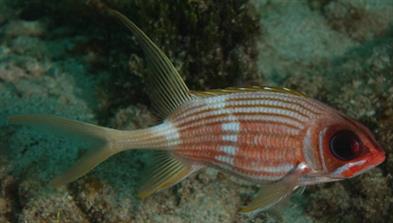



Holocentrus rufus
| Ecological Descriptors |
||||
| Habitat | Size | Diet | Behaviour | Sex |
| Co, S | 35 | Cru, Mol, Ech Noct | I, Sh | F |
Description:
Head and body red, body with light silvery stripes and patches. Tail base and tail fin yellowish white. Elongated rear dorsal fin and upper tail lobe. Spiny dorsal reddish, with a prominent white triangular blotch behind each spine tip. Soft dorsal, anal, pelvic and pectoral fins reddish. Anal fin short compared to superficially similar Longjaw Squirrelfish (Neophion marianaris).
Ecology
Nocturnal, inhabits clear reefs from 0 to 32m (0-100ft). Found near mouths of caves and holes. At night they usually move to sandy areas and grass beds to feed on crabs, shrimps, gastropods and brittle stars.
Territorial ndividual bahaviour, or in schools of 8-10 . They are territorial and defend their retreats from conspecifics.
Life Cycle:
Length at maturity ~14cm.
Two mating seasons per year and have a composite life cycle, with a pelagic stage and a benthic stage. They reproduce by external fertilization, not showing any parental care. During January through March and again in Autumn, the female deposits
its eggs and the male deposits its sperm into the water where fertilisation takes place. Eggs develop into several larval stages. The rhynchichthys stage are thin and silvery, with five spines at the front (rostral) and on the operculum and head, as in other squirrelfish. The rhynchichthys develops into the next pelagic stage the meeki, with less noticeable spines and more streamlined. The silvery pelagic larvae change into the benthic juvenile stage when the necessary conditions are acceptable, "settling".
Head and body red, body with light silvery stripes and patches. Tail base and tail fin yellowish white. Elongated rear dorsal fin and upper tail lobe. Spiny dorsal reddish, with a prominent white triangular blotch behind each spine tip. Soft dorsal, anal, pelvic and pectoral fins reddish. Anal fin short compared to superficially similar Longjaw Squirrelfish (Neophion marianaris).
Ecology
Nocturnal, inhabits clear reefs from 0 to 32m (0-100ft). Found near mouths of caves and holes. At night they usually move to sandy areas and grass beds to feed on crabs, shrimps, gastropods and brittle stars.
Territorial ndividual bahaviour, or in schools of 8-10 . They are territorial and defend their retreats from conspecifics.
Life Cycle:
Length at maturity ~14cm.
Two mating seasons per year and have a composite life cycle, with a pelagic stage and a benthic stage. They reproduce by external fertilization, not showing any parental care. During January through March and again in Autumn, the female deposits
its eggs and the male deposits its sperm into the water where fertilisation takes place. Eggs develop into several larval stages. The rhynchichthys stage are thin and silvery, with five spines at the front (rostral) and on the operculum and head, as in other squirrelfish. The rhynchichthys develops into the next pelagic stage the meeki, with less noticeable spines and more streamlined. The silvery pelagic larvae change into the benthic juvenile stage when the necessary conditions are acceptable, "settling".
Longspine Squirrelfish
Longspine Squirrelfish







99
98

